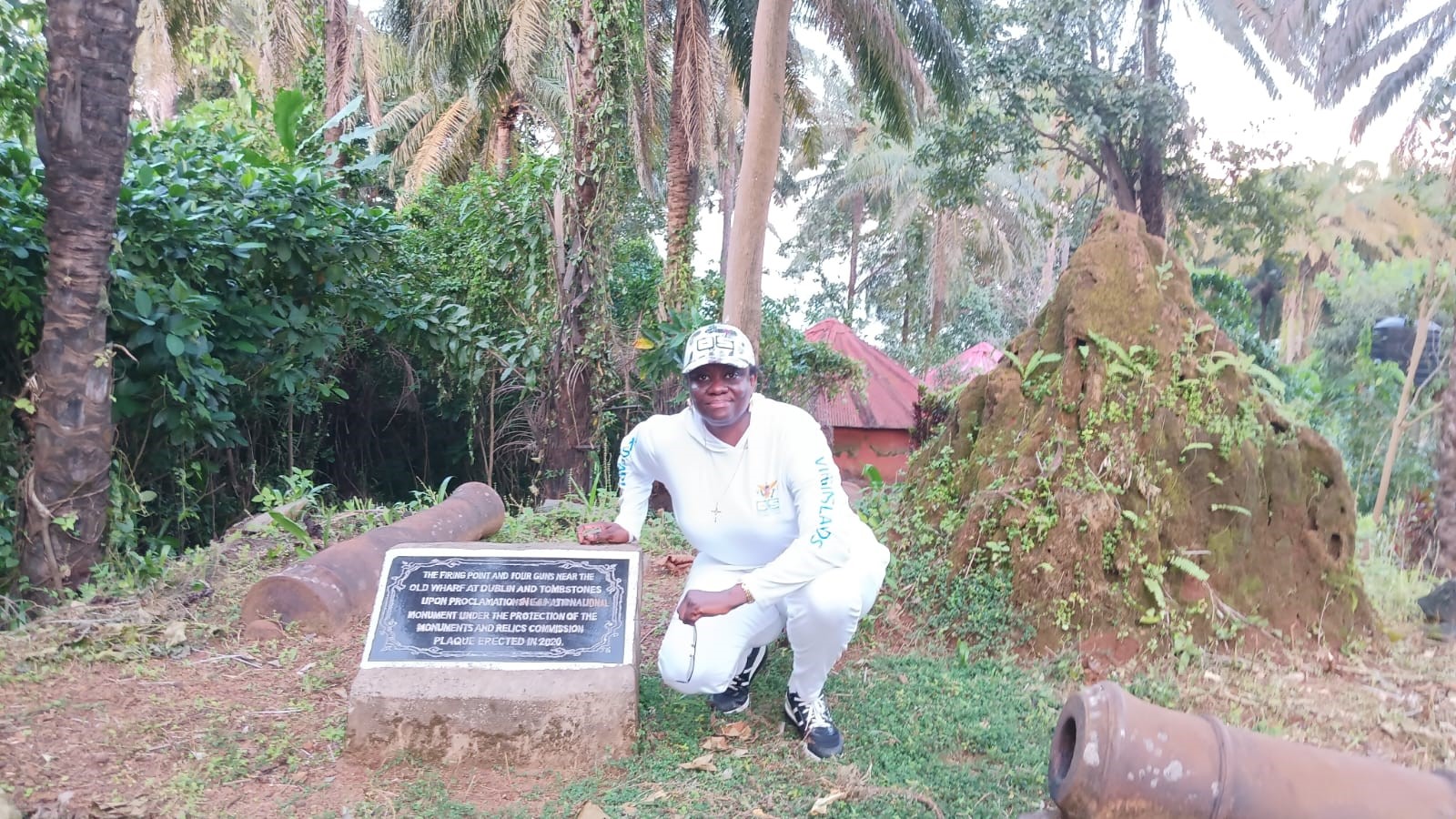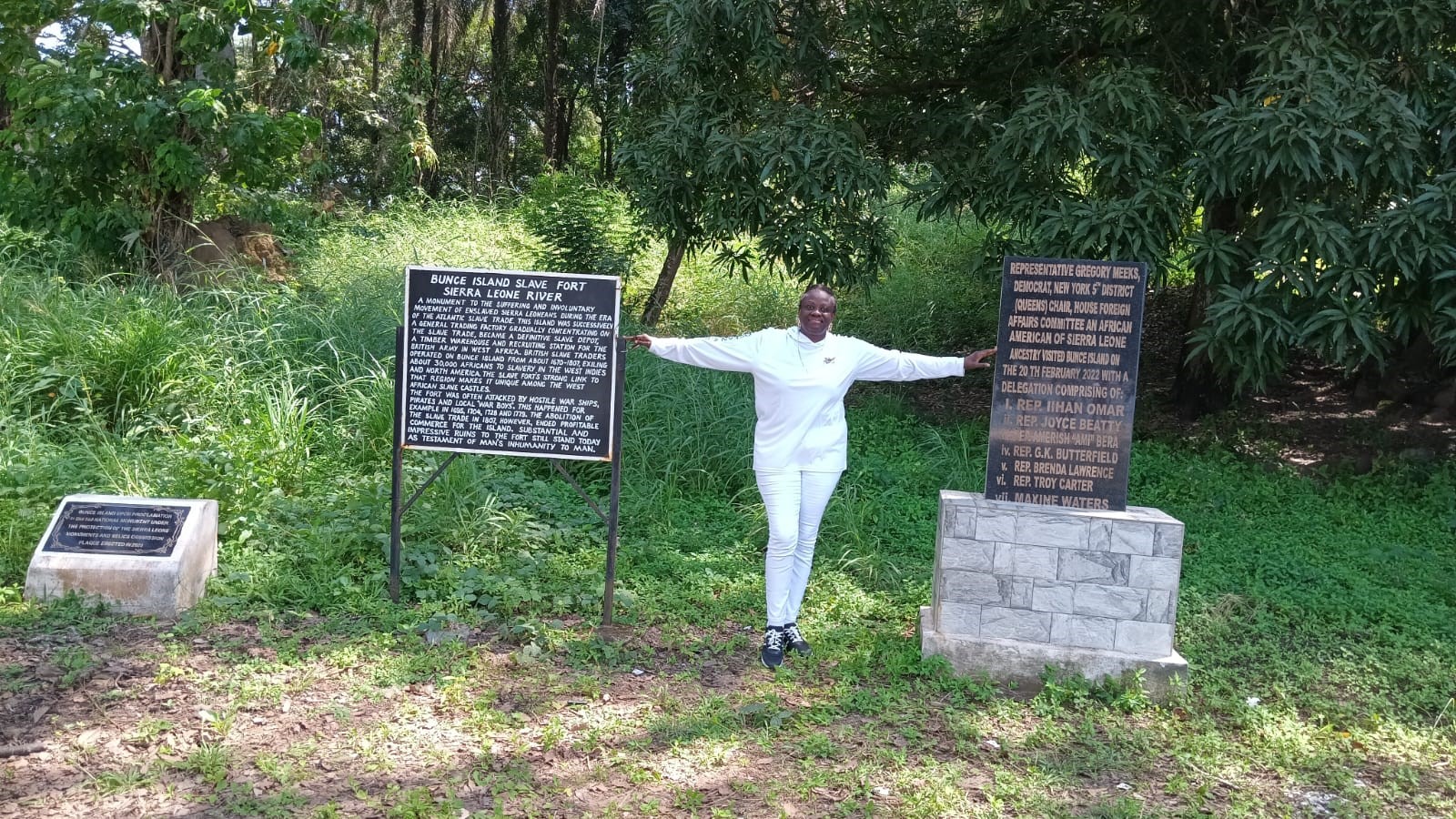Prominent female Sierra Leone activist Dr. Sylvia Olayinka Blyden OOR who is the great great grandchild of Edward Wilmot Blyden (the Father of Pan-Africanism), has taken TV and Radio Journalists on a comprehensive tour to re-trace the painful journeys that the Captured Slaves traversed before they were loaded on to slave ships centuries ago in order to be then sold into bondage in the Americas and in Caribbean Nations like Jamaica, Virgin Islands and Barbados.

Edward Wilmot Blyden, born in 1832, was the leading voice of the 19th Century in the Calls for descendants of slaves to return to the African continent. Due to his activism, he has been termed as the Father of Pan-Africanism.

His great great grandchild Dr. Sylvia Olayinka Blyden has now embarked on steps to emulate her late ancestor in working to connect Africa with Blacks in Nations that used to harbour Slave Plantations.
To ensure she can have fullest experience of trying to understand the pains of slavery has happened on this side of the Trans-Atlantic Trade, Dr. Blyden took Radio and TV journalists from the State Broadcaster SLBC, the private AYV and FTN Media Houses, Epic Radio, Rise Radio, 98.1FM Radio and this Awareness Times newspaper on a journey that lasted the whole of Friday November 3rd 2023.
Using the SEA BIRD boat service, the team traveled by ocean to many slave related monuments including the old Slave Fortress on Bunce Island, the old Slave Fortress at Rotumba Section of Koya Chiefdom, the Kent Village Slave Plantation and Pen and finally, the Banana Islands Slave Trans-shipment point. The aim of the tour, according to Dr. Blyden who hails from the Krio ethnic group that is composed of descendants of freed slaves, was to help her understand the feelings of anguish and pains which her ancestors must have felt when they got captured as slaves and forced to leave Africa centuries ago.
The adventure started at Bunce Island where official Tourism Ministry guides, took Blyden and the media team to examine the Slave Fortress and the “point of no return” which was the gates through which Slaves passed to go and board the ships.
Also visible were cannons used by the British Slave Traders to repel pirates when attacked. Also toured were buildings and yards with walls that separated the male slaves from the female slaves and children slaves.
Also shown was the structure where slaves were marked with a hot red iron as a symbol of ownership.
Many other sad and poignant things were experienced on Bunce Island including a deep cave which was used to keep arms and ammunition as well as separate graveyards; one for the whites and another for the blacks.
Bunce Island was one of the forty major European commercial Forts built along the West African Coast during the slave trade era, where the British traders purchased goods like gold, ivory, timber and most of all, Human Cargo as slaves.
It is said that thousands of Africans were transported from the Bunce Island Fortress into slavery for some 200 years from the 1600s until slavery got abolished in 1800s.
After leaving Bunce Island, Dr. Sylvia Olayinka Blyden and team also visited Ro-Tumba Section of Koya Chiefdom where they explored a Portuguese slave fort constructed in the 15th Century right on the banks of the Sierra Leone river across from Bunce Island. The site portrays a testimony of Portuguese historical linkage with the British on Bunce Island.
At the Ro-Tumba Fortress, a tower spanning hundreds of years was still standing strong and visible. It reportedly was built for the slave masters to look out from there to prevent the slaves from escaping and also critically, to spot any advancing Pirate Ships.
From Ro-Tumba, another boat ride took the team to Kent Village to examine the Slave Yard which has a basement called a “pen” where the slaves were kept like pigs and hogs in the night. During the day, the slaves would be brought out in chains to get some sun and a little food. A drinking trough carved out of stone, was still standing just outside the slave pen and the Tour Guides explained how the slaves will have to bend down to drink like dogs from the trough when they got thirsty.
Back then, after capturing large numbers of slaves in the Kent Village Yard, the large numbers would be transported from the Pen on to an island known as Banana Island. The slaves would be forced to walk through a gate known as the Gate of No Return.
When the British and other Nationalities Slave Traders arrived on Ships at Banana Island to buy slaves, the captured slaves will be forced to walk through another gate that was also known as the “Gate of No Return” and then they will be taken out to the Big Ships on the ocean in small boats.
At Banana Island, the team also examined cannons that were used to fight pirates and most poignantly, a deep pit of a depth of several dozens of meters was examined. The pit on Banana Island was where slaves were thrown in to die, as a result of being sick or unable to work since the slave masters had no use for sick slaves so they did not allocate food to feed them. When you fall sick, you are thrown alive into the deep pit to die down there.
Horrors of the Slave Trade were explained diligently throughout the trip. The entire trip was very educative and brought the horrors of the Slave Trade into a very sharp and painful focus.
It can be recalled that last month of October 2023, Dr. Sylvia Olayinka Blyden got to be highly honoured in the United States Virgin Islands which is where her great great grandfather Edward Wilmot Blyden was actually born as the son of freed slaves.
Dr. Sylvia Blyden says she has been inspired by her experience on the United States Virgin Islands to resuscitate what her great great grandfather started many years ago – the ardent Call to convince Blacks across the World that their place was the African continent.
She noted that her plans go way beyond Sierra Leone. So for her to be able to seriously address the issues on a global level, she has to have a feel of what the slaves went through, hence her visit to the Slave Forts on the Islands and to Slave Yards.
She explained that her next tour will be in Ghana where she plans to visit other Slaves Forts such as Elmina Castle so as to have a more indepth experience and knowledge about the slave trade in Africa.
